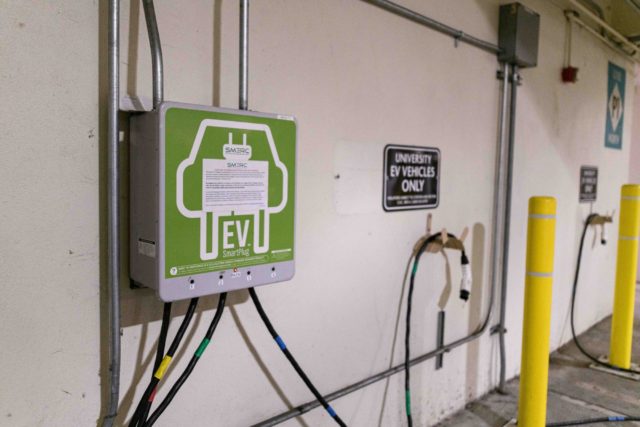UCLA Transportation is planning to expand sustainable transportation and electric vehicle charging facilities on campus in an effort to reduce UCLA’s contributions to transportation emissions.
UCLA Transportation published the Electric Vehicle Readiness Plan on Feb. 9, outlining a process for the university to transition its fleet of buses to electric vehicles, build more electric vehicle charging infrastructure on campus and expand environmentally sustainable student commute options. The plans extend until 2050 and also come as a response to Gov. Gavin Newsom’s September 2020 executive order directing a statewide conversion to electric vehicles by fully prohibiting the sale of carbon-based vehicles by 2035.
The main motivations behind these new changes were state policy, commuter behavior, environmental sustainability and equitable transportation, UCLA Transportation said in a written statement.
According to the plan, almost 40% of California’s emissions were produced by the transportation sector. To accommodate Newsom’s decision, the report added that UCLA Transportation is aiming to remain in alignment with Newsom’s directions.
Some students expressed support for the plan because of concerns about the threatening state of the climate.
Narayan Gopinathan, an environment and sustainability doctoral student, said both he and E3: Ecology, Economy, Equity – a student organization he is a member of that promotes responsible ecological practices among the UCLA community – fully support the transition
Gopinathan said the new ability to utilize electrical vehicles on a larger scale is essential because of the increasing issues surrounding the worsening atmosphere, such as occurrences of extreme weather events.
“Despite the current cold temperatures, we’ve seen global average temperatures have been very high and increasing every year,” Gopinathan said. “We’ve seen the wildfires and heat waves every year, and we know what’s going on.”
The plan also calls for UCLA to better accommodate student commuters who drive electric vehicles to campus. According to the plan, 2.9% of student commuters utilize electric vehicles for transportation as of 2019. UCLA Transportation additionally set a goal to increase electric vehicle usage by commuters to 5% by 2025. Gopinathan said he would like to see the university prepare the proper infrastructure for incoming electric vehicles.
The potential increase in electric vehicle usage on campus necessitates large-scale changes to existing infrastructure in just over a decade, UCLA Transportation added in the statement. The report said parking garages would undergo a significant transition. Currently, 2% of the total parking spots within structures on campus have electric vehicle chargers, but UCLA Transportation said it plans to expand this to 4% by 2025.
UCLA Transportation also said it will expand complimentary existing access to lower-level electric vehicle charging stations to more permit holders, but faster, more advanced stations will have chargers based on the statewide rate of charging services.
To further reduce emissions, the campus will also work to make the BruinBus system and university fleet vehicles electric, the report said. Adam Millard-Ball, acting director of the UCLA Institute for Transportation Studies, said it is essential for the transit systems to be more reliable to make sustainable transportation more attractive to students.
Millard-Ball also expressed the importance of electric vehicle expansion initiatives.
“We’re not going to tackle the climate crisis if we don’t look at transportation,” Millard-Ball said. “Electrification of our transportation system is one way in which we can reduce those emissions.”
Millard-Ball added that there are potential drawbacks to expanding electric vehicle infrastructure. The increased reliance on electric vehicles could potentially crowd the streets, reducing opportunities for alternative sustainable transportation. He added that electric transit systems, biking and walking are environmentally preferable alternatives.
Gopinathan said he believes UCLA Transportation’s plan to expand the electric vehicle accommodations is beneficial to the UCLA community and environment overall.
“It seems like a very good thing because that just enables more EV utilization, and the gas cars themselves cause so many issues,” Gopinathan said. “There aren’t enough EV chargers available for all the people who want to charge their electric vehicles.”


Comments are closed.